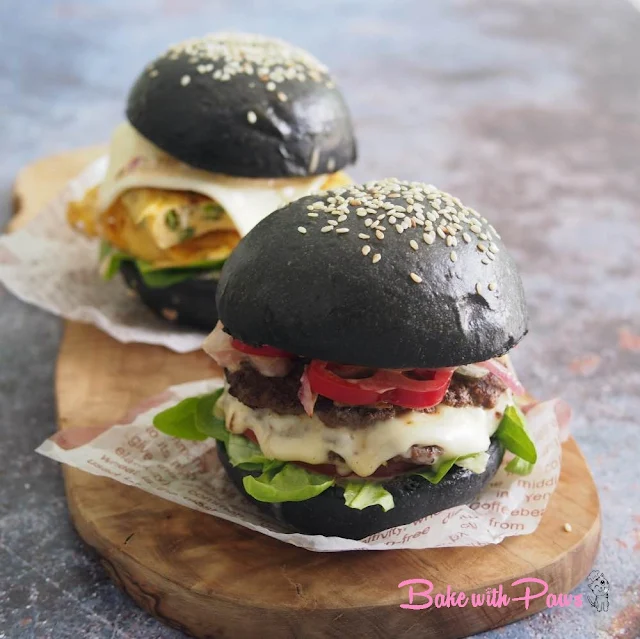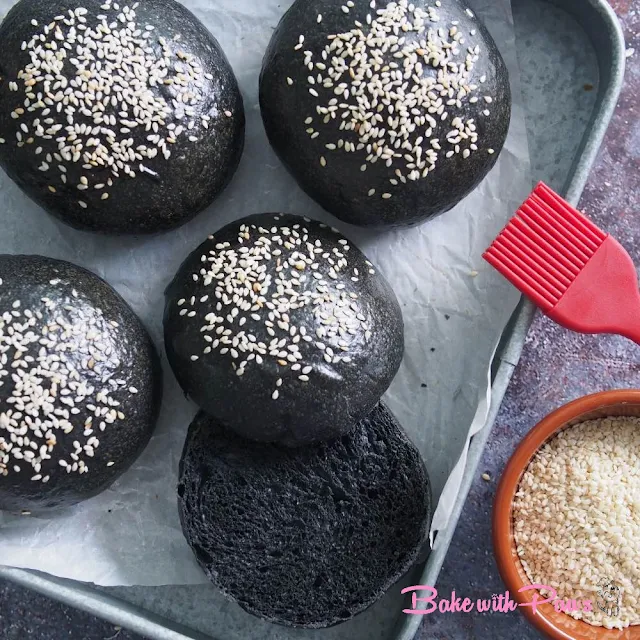Breads (Sourdough) - Soft Buns/Rolls
Charcoal Burger Buns (Sourdough)
October 13, 2022
| Recipe by Bake with Paws
Scroll to the bottom of the page for "PRINT RECIPE".
Charcoal Burger Buns has been in my baking list for long time and this is the perfect month to bake it. I used the same recipe as my Sourdough Shokupan Burger Buns (Sweet Stiff Starter & Yudane Method) that I shared in March 2021. This is the same base used for Sourdough Shokupan.
When you have a good base recipe for soft white sourdough bread, you will want to keep using it. This sweet stiff starter sourdough recipe just works so well for everything. I started using a sweet stiff starter since more than a year ago and I haven't used liquid levain for soft bread since then except for a hybrid recipe. I created this recipe using a high percentage of stiff starter to help to cut down proofing times and make the bread rise faster. The bread is also less sour and sometimes not sour at all. The level of the tangy taste would very much depend on your starter.
An advantage of using the Yudane method is that the bread stays fresh much longer. Please click "Bread Making Method" to understand more details on Yudane Method.
Disclaimer: If you are under medication, it is advisable to consult with your doctor or healthcare professional before consumption as charcoal may interact with certain medications. Please do your own research.
If you have any questions regarding this recipe or any other post, please leave me a comment in the “LEAVE A COMMENT” link and I will reply you as soon as possible. Do tag me on Instagram @Bakewithpaws if you attempt on this recipe.
How To Make Sourdough Charcoal Burger Buns
Yields: 6 buns (10 cm diameter)
INGREDIENTS:
Yudane Dough:
70g bread flour (I used Japan High Gluten Flour)
70g boiling water
Sweet Stiff Starter):
60g sourdough starter (100% Hydration), preferably use at its peak
180g bread flour (I used Japan High Gluten Flour)
75g water or 90g milk
30g sugar (I used organic brown sugar)
Main Dough:
70g bread flour (I used Japan High Gluten Flour)
8g activated charcoal powder
All stiff starter (above)
All the yudane dough (above)
10 - 15g brown sugar (I used organic brown sugar)
1 tsp salt
45g cold egg, whisked (from 1 medium egg)
15g milk, cold
30g butter, room temperature
Topping:
Egg Wash - 1 egg + 1 tbsp water, whisked
Some white sesame seeds
Utensil:
Baking tray
METHOD:
- Yudane:
- Add bread flour in a bowl, pour the boiling water and mix well with spatula or spoon until no dry flour.
- Cling film and leave on the counter for at least 4 hours or overnight in the fridge. I prepared the night before.
- Use directly from the fridge.
- Sweet Stiff Starter
- In a bowl of stand mixer, dilute starter with water or milk, stir in sugar and add in bread flour. Mix with paddle attachment until well mixed and all come together. It can be done by hand mixing too.
- Cover and let it ferment until tripled. I prepared a night before and leave it in aircond room (approximately 24 - 25C room temperature) overnight until tripled. It took about 8 - 9 hours depending on your starter. It should take around 4 - 6 hours to get triple at room temperature at 28C - 30C.
- However, if you feed your starter with milk, the starter will take longer time to proof and very much depend on your stater. Mine took about 9 - 10 hours to proof overnight. And the starter did not rise until triple in size compared feeding with water. It rose almost 2.5 to 3 in size.
- Main Dough:
- Put all ingredients (except butter), including all the stiff starter and yudane dough into a bowl of stand mixer.
- Slightly combine the mixture by hand with the paddle attachment before turning on the machine so that the flour will not splash out. Using the paddle attachment, mix for 2 minutes or until all incorporated. This step is critical to prevent an uneven mixed dough as the stiff starter is rather hard and a dough hook may not be able to mix it well enough.
- Change to hook attachment and knead for another 3 minutes or until the dough comes together. Add in butter and continue knead for 10 - 12 minutes or until reach window pane stage. The whole kneading process, I stopped few times to scrape down the dough from the hook to be sure it is evenly kneaded and also to prevent the motor from overheating.
- 1st Proofing/Resting:
- In the same bowl, let the dough rest for about 45 - 60 minutes. Keep it covered with clingfilm or use a lid. This dough I rested for 45 minutes and the dough rose didn't rise a lot.
- Shaping:
- Transfer the dough to a clean floured surface then divide dough into 6 equal portions (approx. 111g each for mine). Please use a kitchen scale if you want to be exact.
- Form each portion to a ball.
- Place bun onto the baking pan lined with non-stick baking paper. Make sure they are about 1 ½ to 2 inches apart.
- Final Proofing:
- I made marks with a pencil about 1cm away from the original size of the buns. Let the buns proof at a warm place until the dough rise double in size or when it reaches the pencil marks. This one took approximately 2 hours at at room temperature of 30C. The duration of proofing depends on your ambient temperature and starter.
- Baking:
- Preheat oven at 190C (top & bottom heat) or 170C (fan-forced) for 10 - 15 minutes.
- Brush with egg wash and sprinkle some white sesame seeds.
- Bake in a preheated oven for 15 - 20 minutes, or until the sesame seeds get golden brown.
- Remove bread from oven and let them cool on rack.
GENERAL NOTES:
SOURDOUGH STARTER
Please click this link for "How To Make Sourdough Starter" and "Sourdough Maintenance"
A healthy starter is very crucial as advised by Baking with Gina. It is advisable to feed your starter regularly if you want your bread to rise nicely and to use the starter (levain) at its peak. A starter that is fed regularly will be more active in general. If the mother starter is not strong, the bread dough will not rise a lot even though the starter is used at its peak.
GLUTEN DEVELOPMENT & WINDOWPANE TEST
Gluten forms when flour comes in contact with water. Hydration of the flour causes the sticky and stretchy protein to form, giving structure to the bread. This makes your bread trap air and rise.
Gluten in dough can be developed by autolyse, resting, kneading or folding.
The windowpane test is used to determine whether the dough has been sufficiently kneaded. By gently pulling the dough (or you may pinch off some dough) and trying to stretch it into a thin membrane. If you are able to stretch the dough paper thin and translucent without tearing, then the gluten is fully developed. However, if you can stretch it without tearing but the membrane is not transparent, then the gluten is not yet fully developed.
However, from my experience not all the recipe can achieve a thin and translucent window pane stage easily. For example low hydration and low fat dough. For such recipes, a reasonable window pane is good enough and it can be left to rest. Gluten will continue to develop while resting. Exercising restraint to not over-knead the dough prevents the gluten from being overworked and broken. Some of you may have experienced the dough breaking during the second proofing. It is because the dough is over kneaded.
The total kneading time for me is usually 15 minutes at low speeds except brioche dough with high fat percentage or dough using liquid fat which usually takes a little longer (maybe 18-20 mins).
From my experience, I found that high hydration dough with high percentage of fat will be easy to stretch and achieve a paper thin windowpane stage.
KNEADING TIME
For kneading, please regard the timing provided as an indication only. It is only meant as a guide. Timing may differ depending on the brand of flour and electric mixer used. The protein content may vary from one brand of flour to another.
FLOUR
The right flour plays a very important role in bread making. To achieve fluffy, soft and light bread, I used Japan High Gluten Flour in most of my bread baking. The protein content is around 12 - 13%.
HYDRATION
The liquid measurement given is also a guide. It is advisable to always reserve some liquid and not add it all in one go. This would give you the opportunity to adjust if necessary. If dough is too dry, add the reserve liquid one tablespoon at a time until the right consistency. This is because each flour absorbs water and hydrates differently.
PROOFING
Please note that the proofing timing may also vary depending on your climate, environment, flour and your starter.
If you are unable to judge by just looking at the dough, you can do the finger poke test:
Proofing:
- Lightly press the side of the proved dough with your finger. If it bounces back immediately without any indentation, it means the dough is under proved and needs more time before baking.
- If the indentation stays and it doesn’t bounce back, it means it has been over proved.
- If the indentation slowly bounces back and leave a small indentation, it is ready to bake.
- There will be a final burst of rising once the bread is placed to bake in the oven and it is called oven spring.
If your bread collapses or gets wrinkled on top after removing from oven, it could be because your dough over proved during the second proofing. Please proof until the tip of the dough just reaches the rim of the pan, around 80% - 90% in size.
BAKING TEMPERATURE AND TIME
Do also note that the baking temperature and timing provided are what works for my oven and should also be regarded as a guide only. Every oven behaves a little differently, so please adjust accordingly for your oven.
Labels:
Breads (Sourdough) - Soft Buns/Rolls,









Thanks for the recipe! I’ve been thinking of how to use up my leftover charcoal powder too :) Cheers, BlueWren
ReplyDeleteHi, thanks for your comment. I hope you will like this recipe too.
DeleteCheers and happy baking :)
Will I be able to put filling in?
ReplyDeleteYes, of course. Thank you :)
DeleteThank you for sharing recipe! If i I want to double recipe just double everything?
ReplyDeleteHi, You are most welcome:) Yes, just double up the recipe.
DeleteThanks for your interest in this recipe.
Happy baking :)